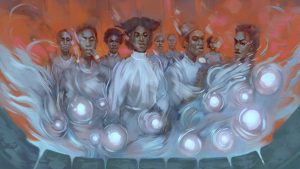Karen Burnham Reviews Short Fiction: Fireside Fiction
One of the lovely parts of being out of the field for a couple of years is catching up with the venues that have blossomed while I’ve been away. Fireside Fiction looks like it was just hitting its stride as I was fading out. Currently edited by Julia Rios, I’ve been quite impressed with their recent offerings.
 One story that stands out for me is “The Secret Lives of the Nine Negro Teeth of George Washington”. It’s well known that George Washington wore false teeth. However they were not made of wood as per one popular myth, but from human and animal teeth and carved ivory. An entry in one of Washington’s ledgers reads: ““By Cash pd Negroes for 9 Teeth on Acct of Dr. Lemoire” and thus is born the story offered by Phenderson Djèlí Clark in the February 2018 issue.
One story that stands out for me is “The Secret Lives of the Nine Negro Teeth of George Washington”. It’s well known that George Washington wore false teeth. However they were not made of wood as per one popular myth, but from human and animal teeth and carved ivory. An entry in one of Washington’s ledgers reads: ““By Cash pd Negroes for 9 Teeth on Acct of Dr. Lemoire” and thus is born the story offered by Phenderson Djèlí Clark in the February 2018 issue.
What follows is nine brief sketches of the men and women who might have contributed teeth to Washington’s dentures. The nine characters are: a blacksmith; a Bonny Man who befriended a merman; a slave self-taught in necromancy; a defiant warrior woman; a conjurer who fought for the British; a woman conjured from another world; a man who used to broker slave trades in Africa–after being enslaved himself he finds himself cursed with immortality; Ulysses, a brilliant chef for the Washingtons; and finally a not so magical woman who spent her whole life at Mt Vernon watching Washington’s family from within at a distance. In an alternate history where sorcery is real, each character brings their own psychic legacy to Washington, related in a brief paragraph at the end of each section, which lend a wonderful rhythm to the story as a whole. Here’s a sample from the blacksmith’s story:
When he wore that tooth, George Washington complained of hearing the heavy fall of a hammer on an anvil day and night. He ordered all iron making stopped at Mount Vernon. But the sound of the blacksmith’s hammer rang out in his head all the same.
Pulling all these characters together neatly defeats any idea that there might be “one true” slave narrative, that slaves would have all been this way or that way. Henrietta rebels every chance she gets and dreams that she is a Yamassee warrior like her grandparents. Solomon, brought here from another world, uses science that appears magical to her community to make Mount Vernon work better for the benefit of all. Ulysses uses the works of Homer as inspiration, using the magic he develops judiciously against the most loathsome folks who dine with Washington before finally transforming himself. But it’s Emma’s tooth, the one least magical, that Washington is wearing when he alters his will to free 123 slaves after Martha’s death. Clark is a historian whose research obviously deeply informs each each sentence, and you can find further context in his essay “Imagining the Past: Speculative Fiction and the Recovering of Black History” in the same issue.
Along similar lines the March issue brings us “Iyanuoluwa–Mercy of God” by Jojo Bee. A young orphaned girl, Iyanu, is sold into slavery, and what follows is a viscerally graphic description of the degradations visited upon her in the hold of the slave ship–just the confinement, filth, beatings, and disease is enough. She starts out with a personal relationship with the Goddess, who tried to give her a warning before she was taken, but in her time in the hold she no longer hears or speaks to that spirit. Finally in the midst of the ship wrecking she perceives the Goddess once again, rescuing her from misery, disease, and the same fate that the immortal middleman character in Clark’s story tries repeatedly to kill himself to avoid. Again, the best thing about having multiple stories, characters, and authors is that one doesn’t have to get locked into debating a single narrative–Iyanu perceives death as freedom and highly-favored Ulysses escapes through shapeshifting, but Solomon chooses to stay at Mount Vernon although she could likely buy her freedom. I appreciate Bee delving into the physical reality of the Middle Passage, one which is easy to gloss over unless confronted with it directly.
(I was also confronted with it when I visited Detroit’s amazing Charles H. Wright Museum of African American History — if you ever get a chance to visit I highly recommend it. Their permanent exhibit “And Still We Rise” covers African history, the Slavery era, and post-Civil War American history with fascinating artefacts and displays, including a full scale portion of a slaver ship’s hold and deck that one can walk through. Also their entrance rotunda has acoustics like I’ve never heard before—a masterwork of architecture.)
While those two stories stood out for me and work well together, there’s a lot more to recommend from Fireside recently. I quite enjoyed the flash fiction “knick knack, knick knack” by Holly Lyn Walrath, about the daughter of a witch having to clean out her mother’s house after she dies. The spirits of the forest are watching her, and it’s nice to see a potentially dark story twist in a positive way at the end. Another excellent story is Marissa Lingen’s on-the-nose “Flow” about a woman who, thanks to her ancestry, is a helper to a community of naiads. After a sinus infection leaves her with a permanent case of vertigo, the naiads no longer recognize her–they had always known her and her father by how they moved, like water. While this is deeply painful, Gigi works on finding other ways to help, studying geology and hydrology, as well as overcoming the fact that her disability, size, and gender all make her as invisible to scientists as her halting walk had made her to the naiads. By the end she has reconnected with at least one naiad and also with confidence.
I should also add that under the art direction of Pablo Defendini, “Flow” and “The Secret Lives of the Nine Negro Teeth of George Washington” are both accompanied by excellent original art by Galen Dara and Odera Igbokwe respectively.
As always I’m looking for new venues and new-to-me voices. If there’s a magazine that you think I should look at or a story you think is fantastic, please let me know at karen.burnham[at]gmail.com, or leave a comment below. There’s only so much I can discuss in a monthly column, but I’d love to hear your tips about where to look for the next shiniest thing!
 While you are here, please take a moment to support Locus with a one-time or recurring donation. We rely on reader donations to keep the magazine and site going, and would like to keep the site paywall free, but WE NEED YOUR FINANCIAL SUPPORT to continue quality coverage of the science fiction and fantasy field.
While you are here, please take a moment to support Locus with a one-time or recurring donation. We rely on reader donations to keep the magazine and site going, and would like to keep the site paywall free, but WE NEED YOUR FINANCIAL SUPPORT to continue quality coverage of the science fiction and fantasy field.








